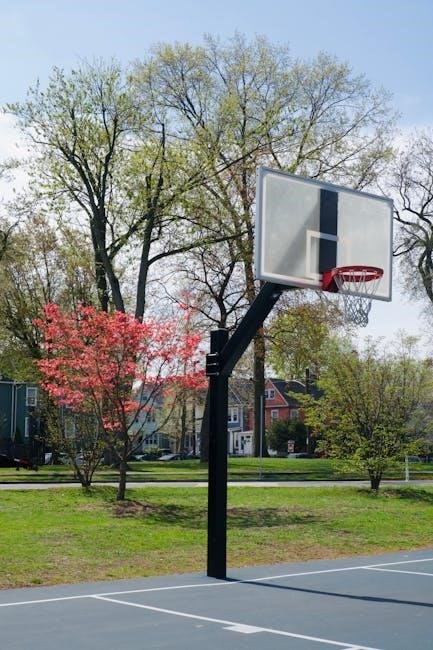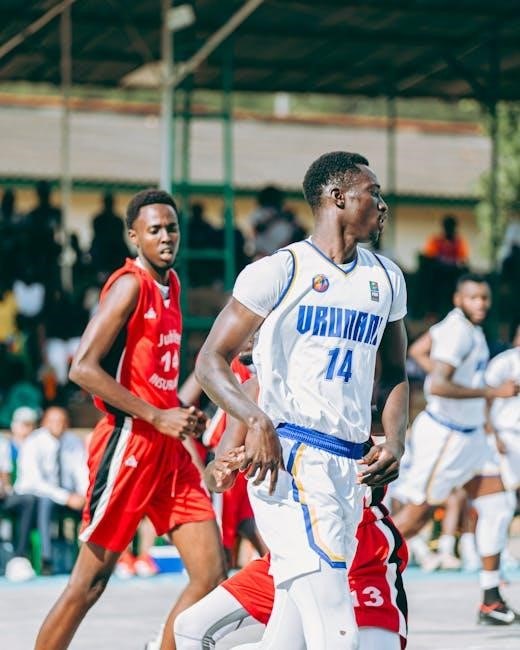Welcome to the world of basketball! This fast-paced team sport involves two teams of five players each, competing over four quarters. The objective is to score by shooting the ball into the opponent’s hoop. Understanding the 10 basic rules is essential for fair play, organized gameplay, and maximum enjoyment.
Overview of Basketball as a Team Sport
Basketball is a dynamic and fast-paced team sport played by two teams of five players each. The game emphasizes teamwork, strategy, and skill, with the objective of scoring more points than the opposing team. Players work together to move the ball up the court and score by shooting it into the opponent’s hoop. The sport requires coordination, communication, and physical fitness, making it a popular activity worldwide. Each player has a specific role, but collective effort is key to success. The game is divided into four quarters, providing structured play and opportunities for tactical adjustments. Basketball’s blend of individual talent and teamwork makes it engaging for both players and spectators.
Importance of Understanding the Basic Rules
Importance of Understanding the Basic Rules
Understanding the basic rules of basketball is crucial for ensuring fair play, safety, and enjoyment. These rules provide a foundation for how the game is played, preventing confusion and disputes. Players who grasp the fundamentals, such as scoring, fouls, and ball movement, can participate effectively and improve their skills. Coaches and referees rely on these rules to maintain order and enforce penalties. Without a clear understanding, participants risk committing violations unintentionally, which can disrupt the flow of the game. Moreover, knowing the rules fosters sportsmanship and respect among players, enhancing the overall basketball experience. It’s essential for everyone involved to learn and adhere to these guidelines to appreciate the game fully.

Structure of a Basketball Game
A basketball game is divided into four quarters, each lasting 8 minutes, played by two teams of five players aiming to outscore opponents.
Number of Players and Teams
In basketball, each team consists of five players on the court at a time, with substitutions allowed during stoppages in play. A standard game is played between two teams, each aiming to outscore the other. Teams can have additional players on their rosters, but only five from each team participate simultaneously. The game also requires officials, such as referees, to enforce the rules and ensure fair play. It’s important to note that a minimum number of players is required to start the game. Understanding the structure of teams and player roles is fundamental to grasping the game’s dynamics and strategies.
Duration of the Game (Four Quarters)
A basketball game is divided into four quarters, each lasting 12 minutes in professional play and 8 minutes in college and high school games. The game begins with the first quarter and progresses through four equal periods. If the score is tied at the end of four quarters, an overtime period of five minutes is played to determine the winner. The total duration includes breaks between quarters and halftime, which is longer between the second and third quarters. Time stops during fouls, timeouts, and when the ball goes out of bounds, extending the actual game length beyond the playing time. Understanding the structure helps players and fans follow the game’s flow effectively.
Objective: Scoring by Shooting the Ball into the Hoop
The primary objective in basketball is to score points by shooting the ball into the opponent’s hoop. Teams take turns playing offense (trying to score) and defense (preventing the other team from scoring). Points are scored through field goals (2 or 3 points, depending on the shot distance) or free throws (1 point each). Players must dribble or pass the ball to advance it, and they have a limited time to shoot due to the shot clock. The team with the most points at the end of four quarters wins the game. This rule is fundamental, as all strategies and plays revolve around scoring efficiently and effectively.

Player Positions and Roles
Basketball teams consist of five key positions: Center (C), Power Forward (PF), Small Forward (SF), Point Guard (PG), and Shooting Guard (SG). Each role has distinct responsibilities.
Center (C): Role in Rebounding and Defense
The center (C) is a pivotal position in basketball, primarily responsible for rebounding and defending the basket. They typically position themselves near the hoop to grab rebounds, both offensively and defensively, to secure possession for their team. Defensively, the center protects the rim by blocking shots and contesting opponents’ attempts. They also set screens to free up teammates for open shots or drives. The center often acts as a physical presence, using their height and strength to dominate the paint. Effective communication and positioning are crucial for their role in coordinating the team’s defense and ensuring rebounds are secured. The center’s contributions are vital to both controlling the boards and anchoring the team’s defensive strategy.

Power Forward (PF): Scoring and Rebounding
The power forward (PF) is a versatile player who excels in both scoring and rebounding. They often play near the basket but can also shoot from mid-range or beyond the 3-point line. Their primary responsibilities include securing rebounds, scoring opportunities, and creating mismatches. The PF is typically the team’s second-tallest player, using strength and agility to outmaneuver opponents. They often serve as a reliable post scorer and are expected to crash the boards for offensive and defensive rebounds. Additionally, the PF may handle the ball in certain situations, making them a crucial all-around contributor. Their ability to score and rebound makes them a key asset to the team’s overall performance and strategy. Effective communication and positioning are essential for their success on the court.
Small Forward (SF): Versatility in Scoring and Defense
The small forward (SF) is often regarded as one of the most versatile positions on the court. They are expected to excel in both scoring and defense, making them a crucial asset to the team. Typically the most athletic player, the SF can score from the perimeter, post, or in transition. Defensively, they often guard the opponent’s best scorer, utilizing quickness and agility to disrupt plays. The SF must also contribute to rebounding and playmaking, often acting as a secondary ball handler. Their ability to adapt to various situations and match up against different types of players makes them indispensable. Coaches rely on the SF to bring balance and flexibility to the team’s offense and defense, ensuring a well-rounded performance throughout the game.
Point Guard (PG): Playmaking and Ball Handling
The point guard (PG) is the team’s floor leader, responsible for ball handling, playmaking, and orchestrating the offense. They must possess exceptional dribbling skills to maintain control under pressure; The PG is typically the first player to bring the ball up the court and set up the team’s offensive plays. Their primary role is to create scoring opportunities for teammates by driving, passing, or shooting. A good PG must have excellent court vision, anticipation, and decision-making abilities. They are also expected to defend the opponent’s best ball handler, applying pressure to disrupt the opposing team’s offense. The PG’s ability to control the tempo of the game and make smart decisions is crucial for the team’s success, making them a pivotal position in basketball strategy.
Shooting Guard (SG): Primary Scoring Responsibility
The shooting guard (SG) is primarily responsible for scoring, particularly from the perimeter. They must possess a reliable three-point shot and the ability to score off the dribble. SGs are often the team’s top scorers, requiring quick reflexes and accuracy. They also need to be effective in one-on-one situations and create their own shots. Additionally, SGs must contribute to team defense, applying pressure on the opponent’s best scorers. Their ability to balance scoring and defensive responsibilities makes them a versatile and crucial component of the team. Effective SGs can stretch defenses and create mismatches, making them essential for offensive success in modern basketball strategies.

Ball Handling and Movement Rules
Basketball requires precise ball handling and movement. Players can dribble or pass, but must avoid illegal moves like traveling or carrying the ball improperly.
Dribbling: Definition and Regulations
Dribbling is a fundamental skill in basketball where a player bounces the ball on the floor while moving. Players can dribble in any direction but must maintain control. A player with the ball must dribble; they cannot hold or carry it. Once a player stops dribbling, they can only move one step without dribbling again. Double dribbling, where a player dribbles, stops, and dribbles again, is not allowed unless they lose possession. Dribbling helps players maintain ball control, create scoring opportunities, and navigate the court effectively. Proper dribbling technique and adherence to rules are essential for fair and dynamic gameplay.
Traveling: Prohibited Movement Without Dribbling
Traveling occurs when a player moves more than two steps without dribbling the ball. This rule ensures fair play and prevents players from gaining an unfair advantage. When a player picks up their dribble, they must pass, shoot, or lose possession within two steps. Excessive movement without dribbling results in a turnover. Referees closely monitor footwork to enforce this rule, maintaining the game’s flow and integrity. Understanding traveling helps players stay within legal movement boundaries, ensuring smooth and competitive gameplay.
Carrying or Palming the Ball: Violations
Carrying or palming the ball is a violation in basketball. This occurs when a player holds the ball for more than five seconds or moves their hand under the ball, preventing dribbling. Players must dribble or pass within the allowed time frame. If a player commits this violation, play stops, and the opposing team gains possession. This rule ensures fair play and maintains the flow of the game. Proper ball handling is essential to avoid such penalties. Coaches often emphasize legal dribbling techniques to prevent palming. Understanding this rule helps players avoid turnovers and keeps the game moving smoothly. It is a fundamental aspect of basketball that every player must master.

Scoring in Basketball
Points are scored by shooting the ball into the hoop. Field goals (2 or 3 points) and free throws (1 point) are the primary scoring methods.
Field Goals: 2-Point and 3-Point Shots

A field goal is a basket scored during regular play. It can be worth two or three points, depending on where the shot is taken. A 2-point shot occurs when a player shoots the ball from inside the 3-point line, while a 3-point shot is taken from behind the 3-point line. The 3-point line is an arc located 23 feet, 9 inches from the basket in professional play and slightly closer in other leagues. Both types of shots require precision and strategy; Teams often aim for 3-pointers to maximize scoring efficiency, but 2-pointers remain a reliable way to score consistently. The shot clock ensures players must attempt a shot within a set time limit, adding pressure to make quick decisions.

Free Throws: Uncontested Shots Due to Fouls
Free throws are uncontested shots taken by a player from the free throw line after a foul is committed by the opposing team. They are awarded to the player who was fouled, allowing them to score without defensive pressure. The number of free throws varies: one shot is awarded for non-shooting fouls, while two or three shots are granted if the foul occurs during a missed field goal attempt. Players must stay behind the free throw line until the ball is released. Successful free throws count as one point each. The ball becomes live after each free throw, enabling rebounds or continued play. Free throws are crucial for maintaining scoring momentum and penalizing unsportsmanlike conduct. Teams often practice free throws to improve accuracy and game performance.
Technical Fouls and Penalty Shoots
Technical fouls are called for unsportsmanlike behavior, such as arguing with referees, excessive contact, or delaying the game. These fouls result in free throws or possession of the ball for the opposing team. Penalty shoots are awarded when a foul occurs during a scoring attempt, giving the offended player uncontested shots. Each successful free throw counts as one point. If a technical foul occurs, the opposing team receives one or two free throws, depending on the situation. Multiple technical fouls can lead to ejection from the game. These rules ensure fair play and maintain the flow of the game, while also penalizing disrespectful or harmful behavior. Proper enforcement of technical fouls and penalty shoots is crucial for maintaining sportsmanship and game integrity. Players and coaches must adhere to these rules to avoid penalties. Understanding these regulations helps teams strategize effectively during critical moments. Free throws and technical fouls are essential components of basketball, influencing both the score and player conduct. Teams often practice free throws to capitalize on these opportunities. Officials rigorously monitor behavior to apply these rules fairly. The consequences of technical fouls can significantly impact the game’s outcome, making them a key focus for players and referees alike. The ability to handle pressure during free throws separates skilled players from the rest. Coaches emphasize the importance of composure and accuracy in these high-stakes situations. By mastering free throws, players can turn defensive lapses into offensive advantages. The mental and physical discipline required for penalty shoots is a testament to the overall skill demanded in basketball. Teams that excel in these areas often gain a competitive edge, highlighting the importance of preparation and focus. The rules surrounding technical fouls and penalty shoots are designed to uphold the integrity of the game while ensuring a balanced and fair competition. They serve as a reminder that basketball is not just about physical prowess but also about mental toughness and respect for the game. Players who can perform under pressure and understand these rules are invaluable to their teams. The strategic implications of technical fouls and penalty shoots make them a critical aspect of basketball strategy. Coaches and players must be well-versed in these rules to make informed decisions during games. The ability to capitalize on free throws can turn the tide of a close game, making them a focal point for both practice and gameplay. The enforcement of technical fouls ensures that the game remains respectful and fair, maintaining the spirit of sportsmanship. By understanding and adhering to these rules, players can elevate their performance and contribute to their team’s success. The interplay between technical fouls and penalty shoots underscores the complexity and nuance of basketball, requiring a blend of skill, strategy, and discipline. These elements are essential for any team aiming to achieve victory and excel in the sport. The rules are continuously refined to address emerging challenges and ensure a level playing field for all participants. As basketball evolves, the importance of technical fouls and penalty shoots remains steadfast, serving as a cornerstone of the game’s regulations. Players and coaches must stay informed about these rules to adapt effectively and maintain a competitive edge. The impact of these rules extends beyond the scoreboard, influencing player behavior and overall game dynamics. They are a vital part of what makes basketball an engaging and strategic sport. The careful enforcement of technical fouls and the strategic use of penalty shoots are integral to the game’s balance and excitement. By grasping these concepts, players can enhance their skills and contribute to a more enjoyable and competitive game environment. The rules surrounding technical fouls and penalty shoots are a key component of basketball’s enduring appeal, ensuring that the game remains both challenging and fair for all involved. Teams that master these aspects often find themselves at the forefront of competition, highlighting the importance of understanding and executing these strategies effectively. The continuous learning and adaptation required to navigate these rules are what make basketball a dynamic and ever-evolving sport. Players who can navigate technical fouls and capitalize on penalty shoots are highly valued, as they bring both skill and composure to the court. The mental and physical challenges presented by these situations are a true test of a player’s abilities. By overcoming these challenges, players demonstrate their dedication and passion for the game. The rules governing technical fouls and penalty shoots are in place to ensure that basketball remains a sport of integrity, skill, and sportsmanship. They play a pivotal role in shaping the game’s outcome and maintaining its appeal. Understanding and respecting these rules is essential for all participants, from players to coaches and officials. The ability to perform under the pressure of penalty shoots and the wisdom to avoid technical fouls are qualities that define a true basketball professional. As the sport continues to grow and evolve, the importance of these rules will remain unchanged, serving as a foundation for fair and competitive play. The strategic and mental aspects of technical fouls and penalty shoots add layers of complexity to the game, making it more engaging for both participants and spectators. The careful balance between physical skill and mental discipline required in these situations is what makes basketball such a captivating sport. By focusing on these elements, players can elevate their game and contribute to the overall success of their team. The rules surrounding technical fouls and penalty shoots are a testament to basketball’s commitment to fairness and excellence, ensuring that every game is a true test of skill, strategy, and character. Players who master these aspects are not only better athletes but also better teammates and competitors. The continuous refinement of these rules reflects the sport’s dedication to improving the game experience for everyone involved. As basketball continues to be a global phenomenon, the importance of technical fouls and penalty shoots will endure, shaping the future of the sport and inspiring new generations of players. The ability to navigate these challenges is what separates champions from contenders, making them a focal point for any aspiring basketball player. The legacy of these rules lies in their ability to maintain the integrity and excitement of the game, ensuring that basketball remains a beloved sport for years to come. By embracing these regulations, players can fully immerse themselves in the game’s traditions and values, fostering a deeper appreciation for the sport. The impact of technical fouls and penalty shoots extends beyond individual games, influencing the overall culture of basketball. They remind us that the game is not just about winning but also about how we conduct ourselves in pursuit of victory. The rules are a reminder that respect, discipline, and fair play are just as important as skill and athleticism. Players who embody these values are true ambassadors of the sport, inspiring others to follow in their footsteps. The enduring relevance of technical fouls and penalty shoots is a tribute to the timeless principles of basketball, ensuring that the game remains a source of enjoyment and growth for all who participate. By upholding these rules, the basketball community continues to promote a positive and inclusive environment, where every player has the opportunity to thrive. The interplay between technical fouls and penalty shoots adds depth to the game, making it a constantly evolving challenge that requires adaptability and resilience. These elements are what make basketball a sport that is both demanding and rewarding, pushing players to their limits while offering moments of triumph and camaraderie. The rules surrounding technical fouls and penalty shoots are a key part of what makes basketball the vibrant and dynamic sport it is today. By understanding and respecting these regulations, players can fully engage with the game’s nuances and contribute to its ongoing legacy. The strategic implications of these rules ensure that no two games are ever the same, keeping the sport fresh and exciting for players and fans alike. The ability to navigate technical fouls and capitalize on penalty shoots is a hallmark of a well-rounded basketball player, combining both physical prowess and mental acuity. As the sport continues to evolve, these rules will remain a cornerstone of basketball, guiding the game into a future filled with new challenges and opportunities. The impact of technical fouls and penalty shoots on the game’s dynamics is undeniable, shaping the strategies and behaviors of players and coaches. They add a layer of complexity that makes basketball a true test of skill, strategy, and character. By mastering these aspects, players can elevate their performance and make meaningful contributions to their team’s success. The rules governing technical fouls and penalty shoots are a testament to basketball’s rich history and its commitment to fair play. They serve as a foundation for the sport, ensuring that every game is a true reflection of the values that basketball embodies. Players who understand and respect these rules are not only better athletes but also better representatives of the
Fouls and Violations
Fouls disrupt gameplay, ensuring fair play. Rules prevent injury and maintain sportsmanship, with penalties like free throws for violations, reflecting basketball’s commitment to integrity and safety.
Personal Fouls: Types and Consequences
Personal fouls involve illegal physical contact with an opponent, disrupting their play. Common types include holding, pushing, or tripping. Consequences vary based on severity. Players committing five fouls are disqualified. Teams gain free throws or possession. Flagrant fouls incur penalties like free throws and possession, impacting gameplay significantly; Understanding these rules ensures fair play and sportsmanship.
Flagrant Fouls: Severe Contact or Unsportsmanlike Behavior
Flagrant fouls are severe violations involving unnecessary or excessive contact, often with intent to harm or intimidate. They are classified as either Flagrant 1 or Flagrant 2, depending on severity. Flagrant 1 involves minor contact, while Flagrant 2 includes physical acts like punching or kicking, leading to ejection. These fouls disrupt fair play and player safety. Officials enforce penalties, such as free throws or possession for the opposing team. Understanding these rules ensures fair competition and protects players from dangerous actions.
- Flagrant 1: Unnecessary contact without excessive force.
- Flagrant 2: Severe, unsportsmanlike acts leading to ejection.
Defensive Fouls: Restrictions in the Paint
Defensive fouls in basketball occur when a defender violates rules while guarding an opponent, particularly in the paint. One key restriction is the three-second rule, which prohibits defenders from staying in the paint for more than three seconds without guarding a player. This rule prevents defensive players from camping out and gaining an unfair advantage. Additionally, defensive fouls include illegal contact, such as reaching in or making unnecessary physical contact with an offensive player. These fouls often result in free throws or possession for the opposing team. Understanding these restrictions ensures fair play and balanced competition.
- Three-second rule: Defenders cannot stay in the paint without guarding a player for more than three seconds.
- Illegal contact: Reaching in or making unnecessary physical contact with an opponent.
Rebounding and Turnovers
Rebounding is securing the ball after a missed shot, giving teams another scoring opportunity. Turnovers occur when possession is lost, often due to steals or errors.
Rebounding: Securing the Ball After a Miss
Rebounding is a crucial aspect of basketball, involving the act of securing the ball after a missed shot. Players can grab the rebound to regain possession for their team. There are two types: offensive rebounds (securing the ball after your team’s missed shot) and defensive rebounds (securing the ball after the opponent’s missed shot). Proper positioning, timing, and physicality are key to effective rebounding. Teams often emphasize boxing out opponents to prevent them from reaching the ball. Rebounding is vital for maintaining control of the game, as it directly impacts possession and scoring opportunities. Mastery of this skill enhances a team’s overall performance and strategy.
Turnovers: Losing Possession of the Ball
A turnover occurs when a team loses possession of the ball to the opposing team. This can happen due to steals, bad passes, or violations like traveling or double dribbling. Teams aim to minimize turnovers to maintain control and scoring opportunities. Turnovers are crucial as they often lead to fast-break scores for the opposing team. Players must focus on proper ball handling and decision-making to reduce turnover risks. Coaches emphasize the importance of protecting the ball, especially in high-pressure situations. Understanding turnover prevention is vital for improving offensive efficiency and overall team performance.
Special Rules and Situations
Basketball includes specific rules to maintain fair play. The shot clock limits shot attempts, while the three-second rule restricts defensive staying in the paint. The five-second rule governs ball handling and inbound plays to keep the game flowing smoothly.
Shot Clock: Time Limit for Attempting a Shot
The shot clock is a critical rule in basketball that ensures the game remains fast-paced and dynamic. It sets a time limit, typically 24 seconds in professional play and 30 or 35 seconds in college or high school games, for a team to attempt a shot after gaining possession of the ball. If the team fails to shoot within this timeframe, the ball is turned over to the opposing team. This rule prevents teams from stalling and promotes continuous action, keeping the game exciting for players and spectators alike. The shot clock resets after rebounds, deflections, or other interruptions, allowing teams to strategize their next play effectively.
Three-Second Rule: Prohibited Defense in the Paint
The three-second rule is a critical aspect of basketball that ensures fair play and prevents defensive stagnation. This rule prohibits defensive players from staying in the paint (the area near the basket) for more than three seconds unless they are actively guarding an opponent. The paint, also known as the key, is a restricted zone where defenders cannot loiter to block shots or intercept passes without violating the rule. If a defender remains in the paint for more than three seconds, a technical foul is called, resulting in free throws for the opposing team. This rule promotes offensive movement and maintains the flow of the game.
Five-Second Rule: Ball Handling and Inbounding
The Five-Second Rule ensures continuous gameplay by limiting the time players can hold or dribble the ball. When a player gains possession of the ball, they must pass, shoot, or move within five seconds. Similarly, during inbounding, the ball must be passed onto the court within five seconds. Failure to comply results in a turnover to the opposing team. This rule prevents stagnation and maintains the game’s pace. It applies to both ball handling in play and inbound situations, ensuring fair and dynamic competition. Understanding this rule is crucial for players to avoid unnecessary penalties and keep the game flowing smoothly.
Mastering basketball starts with understanding its rules. For deeper insights, download the official rulebook PDF or explore guides like “Basketball Rules Explained” for comprehensive learning.
Downloading the Complete Basketball Rulebook PDF
Basketball is a dynamic team sport played by two teams of five players each, aiming to score by shooting the ball into the opponent’s hoop; Key rules include scoring through field goals and free throws, with fouls resulting in penalties. Players must dribble or pass the ball, avoiding illegal moves like traveling or double dribbling. The shot clock ensures offensive play within a time limit, while rebounds and turnovers dictate possession changes. Defensive rules, such as the three-second rule, maintain fair play. Understanding these fundamental rules ensures a structured and enjoyable game. For deeper insights, explore the complete basketball rulebook or guides like “Basketball Basics” and “How to Play Basketball.”